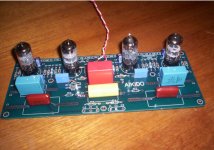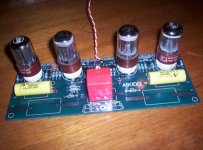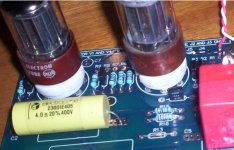SY said:Distortion reduction requires a LOT of supply voltage, and JB's boards are set up so that the same tube envelope carries both top and bottom triode (to more easily allow voltage amp and follower to be different tubes). This means that the tubes' heater-to-cathode voltage ends up being strained. For the case of ECC88-family, one has to take the plate-to-cathode voltage well above the rated maximum to get the distortion to fall below that of a common-cathode stage.
Aha! Thanks for that gem
Thanks for the research- sounds like a tube I should try in this.
Here's an interesting comparison I ran during the last week. With 160V B+, 12.5VRMS output, circuit trimmed to a fare-thee-well, the best of the ECC88-family tubes gave a gain of 18, with -40dB 2HD, -50dB 3HD, -68 4HD, and -69dB 5HD. Bouncing the B+ up to 200V dropped the 2nd by 2dB, 3rd by 3 dB. A brief run up to 280V (totally abusing the heater insulation) showed a 2HD of -50dB.
With the same 160V B+, the same tube in grounded cathode (CCS loaded) direct coupled to a cathode follower (also CCS loaded) gave a gain of 41, and distortion of -46dB 2HD, -70dB 3HD, -80dB 4HD, and -85dB 5HD. So the Aikido shows a clear distortion advantage at high voltages, but not at lower voltages. And half the gain.
Interestingly, the relative ranking of linearity of different ECC88 types that I've tested was quite different between Aikido and grounded cathode. For example, the CCa which was the distortion champion in grounded cathode was among the worst in the Aikido.
I'm looking forward to trying the 6N1P- it seems much more optimal.
Here's an interesting comparison I ran during the last week. With 160V B+, 12.5VRMS output, circuit trimmed to a fare-thee-well, the best of the ECC88-family tubes gave a gain of 18, with -40dB 2HD, -50dB 3HD, -68 4HD, and -69dB 5HD. Bouncing the B+ up to 200V dropped the 2nd by 2dB, 3rd by 3 dB. A brief run up to 280V (totally abusing the heater insulation) showed a 2HD of -50dB.
With the same 160V B+, the same tube in grounded cathode (CCS loaded) direct coupled to a cathode follower (also CCS loaded) gave a gain of 41, and distortion of -46dB 2HD, -70dB 3HD, -80dB 4HD, and -85dB 5HD. So the Aikido shows a clear distortion advantage at high voltages, but not at lower voltages. And half the gain.
Interestingly, the relative ranking of linearity of different ECC88 types that I've tested was quite different between Aikido and grounded cathode. For example, the CCa which was the distortion champion in grounded cathode was among the worst in the Aikido.
I'm looking forward to trying the 6N1P- it seems much more optimal.
The pentode and cascode aikido are as per the tubecad site i.e as you said, single pentode or single cascode for the cascode aikido driving the stacked pair. The distortion reduction here is by unloading the pentode or cascode i.e. letting the pentode load resistor define the load on the pentode and so enable a very well defined load line to be used that optimises the operation of the pentode (cascode) enabling fine tweaking of the distortion level and spectrum. Then there is the noise cancellation of the circuit that helps open the sound up.
If you used the typical low Gm pentode directly then you have a varying and reactive loadline for the poor beastie to drive - the aikido removes that variability or rather reduces it to low levels. High Gm pentodes do not need quite so much help and, as I said n the 2A3 driver thread, make fine DHT drivers without any help.
James
If you used the typical low Gm pentode directly then you have a varying and reactive loadline for the poor beastie to drive - the aikido removes that variability or rather reduces it to low levels. High Gm pentodes do not need quite so much help and, as I said n the 2A3 driver thread, make fine DHT drivers without any help.
James
James D. said:As another example Dave Dove posted his pentode aikido into 300BXLS design a little while ago. I designed the aikido stage and that runs the pentode at a gain of about 110 times.
I have run a pentode aikido at 200 times gain on the bench with no problems and a cascode aikido at a gain of 360 times... yes I'm playing with Aikido RIAA cicuits for a DL103
James
Nice. Please report your findings when you are satisfied. I'd like to use this for an RIAA stage too.
Sheldon
While I would really like to comment on this I will stand back and hold by breath. This stems from asking the guys on the MArantz CD63 67 mod thread if they had performed any distortion tests.
It seems that they can hear far better than any distortion tests that could be performed. It is to be understood that all mods concerning the Marantz should be taken at their word.
I consider your thread to be of considerable interest. If the tone of this thread doesn't go sour I will post some Pentode results as well as P-pont and Bas Aikido measurements. Since my personal analyzer took a dump I can still rely on the equipment at the place I work.
It is interesting to see how some little tweeks can change the distortion figures.
It seems that they can hear far better than any distortion tests that could be performed. It is to be understood that all mods concerning the Marantz should be taken at their word.
I consider your thread to be of considerable interest. If the tone of this thread doesn't go sour I will post some Pentode results as well as P-pont and Bas Aikido measurements. Since my personal analyzer took a dump I can still rely on the equipment at the place I work.
It is interesting to see how some little tweeks can change the distortion figures.
burnedfingers said:It seems that they can hear far better than any distortion tests that could be performed.
I don't find that to be completely true, at least not in the usual sense. Single numerical THD figures are nearly worthless when correlated against perceived quality. Wide band harmonic analyzes of distortion components are extremely useful.
Quote:
I don't find that to be completely true, at least not in the usual sense. Single numerical THD figures are nearly worthless when correlated against perceived quality.
By the term "single numerical THD figures" do you mean distortion figures in a one place decimal? If so I see no mention of single place decimal test results. Please point me towards them so that I might review them.
Quote:
Wide band harmonic analyzes of distortion components are extremely useful.
Would you expect anything less?
I don't find that to be completely true, at least not in the usual sense. Single numerical THD figures are nearly worthless when correlated against perceived quality.
By the term "single numerical THD figures" do you mean distortion figures in a one place decimal? If so I see no mention of single place decimal test results. Please point me towards them so that I might review them.
Quote:
Wide band harmonic analyzes of distortion components are extremely useful.
Would you expect anything less?
quote:
Originally posted by burnedfingers
It seems that they can hear far better than any distortion tests that could be performed.
I don't find that to be completely true, at least not in the usual sense. Single numerical THD figures are nearly worthless when correlated against perceived quality. Wide band harmonic analyzes of distortion components are extremely useful.
Point being that I made no mention to distortion tests in a one place decimal so I fail to see the point. The original Marantz specification call out three place distortion figures. They (Marantz CD 63 67 group) claim there is no need for distortion tests because can hear the differences. Poppycock!
rdf
Is there a mention of one place distortion tests?
No, I don't think so. Yes, I would agree they are worthless. Why bring it up?
Originally posted by burnedfingers
It seems that they can hear far better than any distortion tests that could be performed.
I don't find that to be completely true, at least not in the usual sense. Single numerical THD figures are nearly worthless when correlated against perceived quality. Wide band harmonic analyzes of distortion components are extremely useful.
Point being that I made no mention to distortion tests in a one place decimal so I fail to see the point. The original Marantz specification call out three place distortion figures. They (Marantz CD 63 67 group) claim there is no need for distortion tests because can hear the differences. Poppycock!
rdf
Is there a mention of one place distortion tests?
No, I don't think so. Yes, I would agree they are worthless. Why bring it up?
SY captured the meaning: single numerical, not single digit. I was essentially agreeing with you and disagreeing with those who "...claim there is no need for distortion tests because can hear the differences." Why bring it up? In a thread entitled "Survey: Aikido Distortion" it's relevant. Your post was just a convenient jumping-off point to toss in the notion of in-depth harmonic analysis into the conversation. It's possible I mis-represented those you quoted by presuming they meant a 'one number' approach to THD, but it's my experience those who completely dismiss distortion measurements generally think of it in exactly this way.
JB was kind enough to send me an octal board with premium components (Teflon caps, bulk foil resistors...). Set it up with 5692s, 10mA, 275V B+. At 100Hz, 1kHz, 10kHz, I got identical distortion readings at 2.5VRMS out. -68dB 2nd HD, no other harmonics detectable.
At 15VRMS out, 1 kHz, -53dB 2nd HD, 3rd nudging the low -90s. Nothing else detectable. Very impressive, much better performance than the ECC88 family.
I'll try to get some pix of JB's boards up; they are massively impressive.
At 15VRMS out, 1 kHz, -53dB 2nd HD, 3rd nudging the low -90s. Nothing else detectable. Very impressive, much better performance than the ECC88 family.
I'll try to get some pix of JB's boards up; they are massively impressive.
Sure. Vishay bulk foils for the cathode resistors. The rest are mostly (I think) Yageo metal films. He uses Wima MKP caps for most positions, but does two output CR coupling networks. In one, I have a cheezy Electrocube. In the other, I will mount John's favorite, some super-heavy Russian Teflon caps. For a volume control, he's designed a nifty stepped attenuator, which I don't have a picture of yet. The boards go together quickly; I think it took me about a half hour to stuff one and check it out.
JB favors a high B+. I reran the spectra at 15VRMS out but with a 400V B+. That dropped 2nd HD down to -57dB, 3rd and higher well below residual. So there's something to be said for that, but I'm not sure the extra dissipation is worth it considering how low the distortion already is at lower voltages.
All measurements were cross-checked between a sound card/spectrum analyzer and an HP 3581A wave analyzer.
JB favors a high B+. I reran the spectra at 15VRMS out but with a 400V B+. That dropped 2nd HD down to -57dB, 3rd and higher well below residual. So there's something to be said for that, but I'm not sure the extra dissipation is worth it considering how low the distortion already is at lower voltages.
All measurements were cross-checked between a sound card/spectrum analyzer and an HP 3581A wave analyzer.
- Home
- Amplifiers
- Tubes / Valves
- Survey: Aikido distortion



